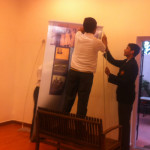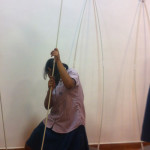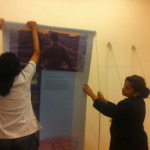28–29 November 2013
The Anne Frank exhibition had finally arrived in India with Calcutta hosting it for the first time—thank you Seagull. Before the exhibition opened for public viewing, 18 students from four schools—La Martinere for Boys, Lakshmipat Singhania Academy, Modern High School for Girls and Calcutta International School—came together for a two-day workshop at the Seagull Foundation for the Arts. Conducted by Aaron Peterer, the workshop trained the students to be guides for the exhibition.
The workshop began with an icebreaking session where the to-be-peer-guides had to group themselves in order of their birth dates. The students were then split into pairs to delve into the story behind each other’s names. Who gave you your name? What does it mean? Share any funny or interesting anecdote with your name . . . After having quite a few laughs over some anecdotes Aaron enunciated a very interesting lesson on how the ‘name’ is something that is shared by every single human being in the world—the most significant marker of one’s identity is, actually, shared with the entire human race. Then what was it that caused one group of people to believe that they were superior? What was it that caused the annihilation of 6 million Jews? With these thoughts in mind, the students watched The Short Life of Anne Frank to be transported into a world where Adolf Hitler was rising in power.
Post the screening of the film and a deafening silence, all the students moved towards the exhibition arena to set up the show. Boxes of fibreglass sticks and rolls of disconnected flex sheets metamorphosed into the exhibition Anne Frank—A History for Today after two hours of fixing, tugging and redoing. The pleasures of viewing the exhibition for the first time even before it is officially open . . . the gratification of getting it in order, satisfying the OCDs of seventeen other peers and Aaron . . . the sweaty happiness of perfection . . . the final run through before shouting a ‘DONE’ and a huge round of applause.
Once the exhibition was completely set, all the guides went through each and every panel in excruciating detail before breaking for lunch. After a sumptuous Indianized-Italian meal the guides grouped again upstairs to study the catalogue and understand the context of some of the pictures used in the exhibition. Interpreting each of the pictures, each group had to come up with four questions that would connect the political scenario of Anne Frank’s time to lessons for today. Armed with the questions the peer guides split into four groups, donning their creative superpowers, to make posters with one picture each as the central theme. Each group then presented their poster, each of which contained thought provoking questions. ‘What would have happened if there was no Hitler?’ ‘What is the value of money in a situation where life is of no worth?’, ‘What is the future for the children?’ and so on. With splashes of colours and thought provoking questions, day 1 of the Peer Guide Training came to a close.
Day two began earlier than planned because the guides were enthralled by sessions with Aaron. The connection he established with the students was evident when they all exchanged email ids, promising to be in touch. The day began with Aaron’s feedback for all the posters that were presented. Interesting aspects that most students did point out was that Hitler rose as a ‘saviour figure to the failed nation of Germany, which was demolished with the Treaty of Versailles’; ‘he was a good leader until the power to control got into his head.’ Aaron’s answers to these statements were fairly simple: The power of the image. He created such an image that made Jewishness define ones life and not in a good way. The rest of the day was spent in doing mock tours and improving presentation skills. Each of the peer guides had to choose one picture that affected him/her the most and presented the entire exhibition keeping that single picture as the focal point. This exercise reemphasized the humanitarian angle behind the entire exhibition. ‘The Red Thread’ was an interesting way of mind mapping for the guides to move flawlessly through the exhibition. Each guide individually had to choose a series of pictures, one from each panel, which would become his/her personal marker upon which the entire exhibition would be explained.
After a short yet fun session on posture and body language, the guides went back to producing masterpieces in stick figures to discuss the qualities of a great guide. ‘Smart’, ‘confident’, ‘knows the subject well’, ‘interesting’, ‘involving’, ‘maintains good eye contact’, ‘involves everyone in the group’, ‘fun’ and ‘like Aaron’ were some of the most commonly discussed characteristics.
Towards the end of the day the eighteen students, who began as just a group of students interested in history of Anne Frank and human rights, had transformed into professional guides for the international travelling exhibition Anne Frank—A History for Today.
—Anugraha Madhavan







